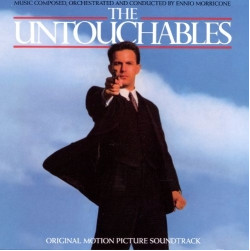主页--->m-comment-000--->mb-comment-012-118
|
电脑版 |
|||||||||||||||||||||||||||||||||||||||||||||||||||||
布罗克斯顿评说莫里康内 MB-012-118 |
||||||||||||||||||||||||||||||||||||||||||||||||||||||
THE UNTOUCHABLES – Ennio Morricone |
||||||||||||||||||||||||||||||||||||||||||||||||||||||
FA8708 THE UNTOUCHABLES (义胆雄心 / 铁面无私 ) |
||||||||||||||||||||||||||||||||||||||||||||||||||||||
作者 乔纳森·布罗克斯顿 (Jonathan Broxton) |
||||||||||||||||||||||||||||||||||||||||||||||||||||||
ENNIO MORRICONE 评论,第12部分 012-118 |
||||||||||||||||||||||||||||||||||||||||||||||||||||||
 |
||||||||||||||||||||||||||||||||||||||||||||||||||||||
贱民——埃尼奥·莫里康内 2017年6月15日
复倒退30年 乔纳森·布罗克斯顿(Jonathan Broxton)的原始评论 几十年来,黑帮老大阿尔·卡彭(Al Capone)丰富多彩的生活吸引了美国公众的想象力。在 1920 年代末和 1930 年代初的禁酒令时代,他是芝加哥臭名昭著的犯罪头目,同样受到爱戴、鄙视和恐惧——芝加哥工人阶级社区的许多人将他视为罗宾汉人物,帮助城市的受压迫者。在1929年残酷的情人节大屠杀之后,对他的态度发生了变化,此后执法人员更加执着于将他绳之以法。布莱恩·德·帕尔马 (Brian De Palma) 1987 年的电影《贱民》讲述了这个基本真实故事的戏剧性版本,顽强的联邦特工埃利奥特·尼斯 (Elliot Ness) 组建了一支由同样坚定的调查员组成的团队,试图一劳永逸地结束卡彭的犯罪活动。这部电影由凯文·科斯特纳饰演内斯,罗伯特·德尼罗饰演卡彭,肖恩·康纳利饰演内斯厌世的前警察搭档吉米·马龙,这个角色为他赢得了奥斯卡最佳男配角奖。 《贱民》的配乐由意大利大师埃尼奥·莫里康内创作,是德·帕尔马和莫里康内三部合作作品中的第一部,其他三部分别是1989年的《越战创伤》和2000年的《火星任务》。莫里康内在前一年凭借《使命》获得奥斯卡提名,1987 年他正处于美国主流制片厂人气的顶峰,即使在他漫长而杰出的职业生涯中,他也享受着最富有成效的时期之一,而《贱民》是那个时期出现的最杰出的作品之一。《贱民》完全是管弦乐,主题丰富,有力而充满激情,有时甚至荒谬大胆,可以看作是莫里康内如此惊人的作曲家的提炼。他将咄咄逼人的现代主义动作和悬疑音乐与华丽的浪漫主义写作、适合时代感的爵士乐和激动人心的胜利主义并置在一起,在各个层面上都是杰作。 1987年在A&M唱片公司发行的原声带专辑是一首极好的音乐,但结构非常奇怪,没有叙事流程,曲目放置看似随意,所以我不会试图从戏剧性发展的角度来理解它,而是简单地谈谈音乐和它有多美妙。开场提示实际上是最后一个,“贱民(片尾标题)”,这是一首令人振奋的、完全管弦乐的美国乐曲,在三分钟的时间里不断建立,直到结局让你欣喜若狂。铜管乐、跳舞的弦乐和优雅的木管乐器口音都很棒; 从风格上讲,它的一部分让我想起了他为 1999/2000 年的三重奏 The Legend of 1900、Canone Inverso 和 Mission to Mars 创作的音乐,其中华丽的盛会穿插着长笛最微小的爵士乐变化。它只是光荣的,它在专辑中期提示“Victorious”和“The Untouchables”中的重演同样令人愉悦。 具有讽刺意味的是,莫里康内根本不喜欢这些作品。在2001年接受《卫报》亚当·斯威汀(Adam Sweeting)采访时,他回忆说,德帕尔马要求他写“为警察写一篇凯旋曲”,但他最初不愿意这样做。他接着说,他“总共写了九篇不同的作品”,但敦促德帕尔马不要选择“第七篇,因为这是最糟糕的”。当然,第七个是电影中的那个,在这种情况下,我同意德帕尔马的品味而不是莫里康内的品味。 然而,最知名的音乐可能是“The Strength of the Righteous (Main Title)”,这是一首绝对的亮点,是专辑中的第八首曲目。仅从编排的角度来看,提示应该是一团糟:独奏口琴、断奏钢琴、柔和的铜管、弦乐、合成器和现代摇滚/流行打击乐部分。谁为这种合奏团写音乐?好吧,埃尼奥·莫里康内(Ennio Morricone)做到了,与所有传统智慧相反,它就像黑帮破坏者一样,就像他所有看似奇怪的乐器组合一样。强烈、不可阻挡的推进核心讲述了 Ness 和他的同伴们坚持不懈的顽强,而不可预测的节奏节拍表明他们愿意改变规则来完成工作。莫里康内在 1960 年代的意大利面西部片的数十首乐谱中出色地使用了口琴,它经常与孤独和一心一意联系在一起,这里也可以这样说。这是否指的是尼斯或卡彭,还有待解释——人们经常说它们是同一枚硬币的两面。 说到疤面煞星,“阿尔·卡彭”本人有一个主题,一种故意的老式旋律,钢琴上有斯科特·乔普林 (Scott Joplin)拉格泰姆的影子,铜管乐中有古典意大利乐句的影子; 旧世界的欧洲与新世界的美国相遇。后半部分出现的哇哇铜管和轻快的流行节拍是复古的莫里康内,他会为 1970 年代的欧洲惊悚片写这种东西。作为美国历史上最令人恐惧的犯罪头目之一的音乐身份,它不应该起作用,但它绝对起作用,是自我夸大的招摇和虚张声势的化身。 美感来自两段简单、华丽的旋律写作。第一个是“死亡主题”,重新审视了阿尔·卡彭主题中听到的一些爵士乐想法,但使它们更柔和、更流畅、更亲密,优美的萨克斯管线以优雅的弦乐为基础。第二首,正如在《尼斯和他的家人》中听到的那样,是一首典型的莫里康内浪漫曲,一首郁郁葱葱、长线条、略带苦乐参半的弦乐和长笛独奏旋律,让人想起他在这种类型的一些最佳作品:天堂电影院、La Tenda Rossa、La Califfa。 动作、紧张和悬疑的音乐,在“Waiting at the Border”和“The Man With the Matchs”等线索中,黑暗而激烈,疯狂的木管乐器人物加入了鲜明的低音吉他脉冲、钢琴和弦、口琴音色和打击乐,参考了正义的力量主题。《在屋顶上》强调了电影的中心动作序列,是《正义的力量》主题的另一种变体,采用了相同的管弦乐队、相同的旋律和相同的节奏核心,但通过一些前卫的弦乐写作来扩展它,在小提琴、中提琴和大提琴之间切换,以说明尼斯、马龙和其他贱民面临的危险。“False Alarm”是一首简短而激烈的弦乐和木管乐器不和谐音,而在专辑结尾的“Machine Gun Lullaby”作品中,莫里康内将许多相同的想法与孩子般的八音盒旋律融合在一起——同样,这是一个听起来很荒谬的创造性选择,但通过天真之美和鲜明悬念之间的并置,它以某种方式创造了一种令人不安的情绪。 莫里康内凭借《贱民》在两年内第二次获得奥斯卡金像奖提名,但最终输给了坂本龙一、大卫·伯恩和苏聪凭借《末代皇帝》获得的压倒性成绩。然而,这首配乐确实赢得了英国电影学院奖和格莱美奖,随着时间的推移,这首配乐被正确地认为是莫里康内为美国电影写的最好、最重要的作品之一。 2012 年,为了纪念这部电影上映 25 周年,La-La Land Records 和制片人 Dan Goldwasser 和 Neil S. Bulk 发行了一套特别的 2 张 CD 套装《贱民》。第一张光盘包含电影中听到的完整配乐,扩展到 55 分钟,重新制作和重新排序以更具戏剧性,标志性的主标题在开头,庆祝的结尾标题在结尾。第二张唱片包含原始A&M原声带的重新制作版本,以及一些奖励曲目和源音乐作品,包括由Randy Edelman演唱的歌曲演示 - “The Untouchables的爱情主题”。《La-La Land》专辑限量发行3张,已经绝版了一段时间,但A&M原版专辑仍然有售; 无论你是选择更简洁的版本,还是能够找到更奢侈的豪华版,《贱民》对于任何想要了解是什么让埃尼奥·莫里康内成为天才的人来说都是必不可少的购买。 从英国电影音乐商店购买《贱民》原声带 曲目列表:
片长:39分20秒(A&M) 片长:113分12秒(La-La Land) A&M Records 393-909-2 (1987) La-La Land LLLCD-1236 (1987/2012) 音乐由埃尼奥·莫里康内(Ennio Morricone)作曲和指挥。埃尼奥·莫里康内(Ennio Morricone)的编排。由Greg Fulginiti录制和混音。由托马斯·德雷舍尔(Thomas Drescher)编辑。乐谱由埃尼奥·莫里康内(Ennio Morricone)制作。2012年《La-La Land》专辑由Dan Goldwasser和Neil S. Bulk制作 |
||||||||||||||||||||||||||||||||||||||||||||||||||||||
2017.6.15 |
||||||||||||||||||||||||||||||||||||||||||||||||||||||
|
| ||||||||||||||||||||||||||||||||||||||||||||||||||||||
以下是原文
| ||||||||||||||||||||||||||||||||||||||||||||||||||||||
ENNIO MORRICONE REVIEWS, Part 12-118 |
||||||||||||||||||||||||||||||||||||||||||||||||||||||
THE UNTOUCHABLES – Ennio MorriconeJune 15, 2017
THROWBACK THIRTY Original Review by Jonathan Broxton The colorful life of gangster Al Capone has captured the imagination of the American public for decades. He was the notorious crime boss of Chicago during the prohibition era in the late 1920s and early 1930s, and was beloved, despised, and feared in equal measure – many in Chicago’s working class neighborhoods saw him as a Robin Hood figure, helping the downtrodden of the city. Attitudes towards him changed in the aftermath of the brutal St. Valentine’s Day Massacre in 1929, after which law enforcement officials became more intent on bringing him to justice. Brian De Palma’s 1987 film The Untouchables tells a dramatic version of this largely true story, as dogged federal agent Elliot Ness forms a team of equally determined investigators in an attempt to end Capone’s criminal activity once and for all. The film starred Kevin Costner as Ness, Robert De Niro as Capone, and Sean Connery as Ness’s world-weary ex-cop partner Jimmy Malone, a role which won him an Academy Award for Best Supporting Actor. The score for The Untouchables is by the Italian maestro Ennio Morricone, and was the first of the three collaborations between De Palma and Morricone, the others being Casualties of War in 1989 and Mission to Mars in 2000. Having received an Oscar nomination for The Mission the previous year, Morricone was at the height of his mainstream American studio popularity in 1987, enjoying one of the most fruitful periods even within his long and distinguished career, and The Untouchables is one of the most outstanding works to emerge from that period. Fully orchestral, overflowing with themes, powerful and passionate, and at times ridiculously audacious, The Untouchables can be seen as a distillation of what makes Morricone such an astonishing composer. His juxtaposition of aggressive, modernistic action and suspense music against gorgeous romantic writing, period-appropriate jazz, and rousing triumphalism is a masterpiece on every level. The original 1987 soundtrack album, on A&M Records, is a superb piece of music, but is structured incredibly oddly, with no narrative flow, and seemingly random track placement, so instead of trying to make sense of it in terms of dramatic development, I’ll simply talk about the music and how wonderful it is. The opening cue is actually the last one, “The Untouchables (End Title),” a glorious piece of rousing, fully-orchestral Americana that builds and builds over the course of it’s three minutes, until the finale leaves you in raptures. The brass fanfares, the dancing strings, and the elegant woodwind accents are all magnificent; stylistically, parts of it remind me of the music he wrote for the 1999/2000 trio The Legend of 1900, Canone Inverso, and Mission to Mars, where the flamboyant pageantry is interspersed with the tiniest inflections of jazz from the flutes. It’s just glorious, and its reprises in the mid-album cues “Victorious” and “The Untouchables” are similarly crowd-pleasing. Ironically, Morricone didn’t like these pieces at all; in a 2001 interview with Adam Sweeting of The Guardian he recalled that De Palma asked him to write “a triumphal piece for the police,” but that he was initially reluctant to do so. He went on to say that he “wrote nine different pieces in total,” but urged De Palma not to choose “the seventh, because it was the worst”. Of course, the seventh one is the one in the film and, on this occasion, I agree with De Palma’s taste over Morricone’s. However, probably the most recognizable piece of music is “The Strength of the Righteous (Main Title),” an absolute showstopper which shows up as the eighth track on the album. Just from an orchestration point of view the cue should be a mess: solo harmonica, staccato piano, muted brass, strings, synths, and a modern rock/pop percussion section. Who writes music for that sort of ensemble? Well, Ennio Morricone does, and against all conventional wisdom it works like gangbusters, just like all his seemingly bizarre instrumental combinations have always done. The intense, unstoppable propulsive core speaks to the persistent doggedness of Ness and his cohorts, while the unpredictable rhythmic beats illustrates their willingness to bend the rules to get the job done. The harmonica, which Morricone has used brilliantly in dozens of scores dating back to his 1960s spaghetti westerns, has often been associated with loneliness and single-mindedness, and the same can be said here. Whether this is referring to Ness or Capone is left open to interpretation – it has often been said they were two sides of the same coin. Speaking of Scarface, “Al Capone” himself has a theme, a purposefully old-fashioned melody that has hints of Scott Joplin ragtime in the pianos and classical Italianate phrasing in the brass; old world Europe meeting new world America. The wah-wah brasses and light pop beats that crop up in the second half are vintage Morricone, the sort of thing he would have written for a 1970s Euro-thriller. As a musical identity for one of the most feared crime bosses in American history, it shouldn’t work, but it absolutely does, the personification of self-aggrandizing swagger and bravado. The beauty comes through two pieces of simple, gorgeous melodic writing. The first, the “Death Theme,” revisits some of the jazz ideas heard in Al Capone’s theme but makes them softer, smoother, and more intimate, with a beautiful saxophone line underpinned by a bed of elegant strings. The second, as heard in “Ness and His Family,” is a prototypical Morricone romance piece, a lush, long-lined, slightly bittersweet melody for strings and solo flute that recalls some of his best efforts of that type: Cinema Paradiso, La Tenda Rossa, La Califfa. The action, tension, and suspense music, in cues like “Waiting at the Border” and “The Man With the Matches,” is dark and intense, with frantic woodwind figures joining the stark bass guitar pulses, the piano chords, the harmonica tones, and the percussion hits that reference the Strength of the Righteous theme. “On the Rooftops,” which underscores the film’s central action sequence, is another variation on the Strength of the Righteous theme, taking the same orchestrations, same melody, and same rhythmic core, but expanding it out with some avant-garde string writing which shifts around between violins, violas, and cellos, to illustrate the danger that Ness, Malone, and the other Untouchables face. “False Alarm” is a brief, intense piece of string and woodwind dissonance, while in the “Machine Gun Lullaby” piece that closes the album, Morricone blends many of these same ideas with a child-like music box melody – again, a creative choice that sounds ridiculous, but which somehow creates an unnerving mood through the juxtaposition between innocent beauty and stark suspense. Morricone received his second Academy Award nomination in two years for The Untouchables, but ultimately lost the award to Ryuichi Sakamoto, David Byrne, and Cong Su’s all conquering score for The Last Emperor. However, the score did win both a BAFTA and a Grammy Award, and over time the score has come to be rightly regarded as one of the best, and most important, works Morricone ever wrote for an American film. In 2012, to recognize the 25th anniversary of the film, La-La Land Records and producers Dan Goldwasser and Neil S. Bulk released a special 2-CD set of the score for The Untouchables. The first disc contains the complete score as heard in the film, expanded to 55 minutes, re-mastered, and re-sequenced to make more dramatic sense, with the iconic main title at the beginning, and the celebratory end title at the end. The second disc contains a re-mastered version of the original A&M soundtrack, along with a number of bonus tracks and source music pieces, including a song demo – “Love Theme from The Untouchables” – performed by none other than Randy Edelman. The La-La Land album, which was limited to 3,500 copies, has been out of print for some time, but the original A&M album is still very much available; whether you go for the more concise version, or whether you are able to track down the more luxurious deluxe edition, The Untouchables is an essential purchase for anyone who wants to understand what makes Ennio Morricone a genius. Buy the Untouchables soundtrack from the Movie Music UK Store Track Listing:
Running Time: 39 minutes 20 seconds (A&M) A&M Records 393-909-2 (1987) Music composed and conducted by Ennio Morricone. Orchestrations by Ennio Morricone. Recorded and mixed by Greg Fulginiti. Edited by Thomas Drescher. Score produced by Ennio Morricone. 2012 La-La Land album produced by Dan Goldwasser and Neil S. Bulk. |
||||||||||||||||||||||||||||||||||||||||||||||||||||||
June 15,, 2017 |
||||||||||||||||||||||||||||||||||||||||||||||||||||||
本站电影欣赏 |
||||||||||||||||||||||||||||||||||||||||||||||||||||||
在线音乐试听 |
||||||||||||||||||||||||||||||||||||||||||||||||||||||
|
||||||||||||||||||||||||||||||||||||||||||||||||||||||
 |
||||||||||||||||||||||||||||||||||||||||||||||||||||||
Jon 是一位电影音乐评论家和记者,自 1997 年以来一直担任全球最受欢迎的英语电影音乐网站之一 Movie Music UK 的编辑和首席评论员,并且是国际电影音乐评论家协会 (IFMCA) 的主席。在过去的 20多 年中,Jon 撰写了 3,000 多篇评论和文章,并进行了多次作曲家采访。在杂志刊物方面,乔恩曾为《电影配乐月刊》、《原声带杂志》和《电影音乐》等出版物撰写评论和文章,并为普罗米修斯唱片公司的两张经典 Basil Poledouris 配乐专辑《Amanda》和《Flyers / Fire on the Mountain》撰写了衬垫注释。他还为汤姆·胡佛 (Tom Hoover) 于 2011 年出版的《Soundtrack Nation: Interviews with Today's Top Professionals in Film, Videogame, and Television Scorering》一书撰写了一章。在1990年代后期,乔恩是伦敦皇家爱乐乐团的电影音乐顾问,并与他们合作拍摄了约翰·德布尼(John Debney)的音乐电影《相对价值》(Relative Values)和奥利弗·海斯(Oliver Heise)的音乐《佛陀的指环》(The Ring of the Buddha),以及与兰迪·纽曼(Randy Newman)合作的一系列音乐会。2012年,乔恩在波兰克拉科夫举行的第五届年度电影音乐节上担任“电影节学院”主席。他是作曲家和作词家协会的成员,该协会是作曲家、作词家和词曲作者从事电影、电视和多媒体工作的首要非营利组织。 |
||||||||||||||||||||||||||||||||||||||||||||||||||||||
2023.12.20 |
||||||||||||||||||||||||||||||||||||||||||||||||||||||
2023 手机版 |
||||||||||||||||||||||||||||||||||||||||||||||||||||||
|
||||||||||||||||||||||||||||||||||||||||||||||||||||||













